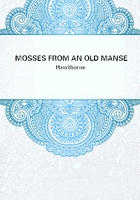
第44章 FEATHERTOP: A MORALIZED LEGEND(1)
"Dickon," cried Mother Rigby, "a coal for my pipe!"The pipe was in the old dame's mouth when she said these words.
She had thrust it there after filling it with tobacco, but without stooping to light it at the hearth, where indeed there was no appearance of a fire having been kindled that morning.
Forthwith, however, as soon as the order was given, there was an intense red glow out of the bowl of the pipe, and a whiff of smoke came from Mother Rigby's lips. Whence the coal came, and how brought thither by an invisible hand, I have never been able to discover.
"Good!" quoth Mother Rigby, with a nod of her head. "Thank ye, Dickon! And now for making this scarecrow. Be within call, Dickon, in case I need you again."The good woman had risen thus early (for as yet it was scarcely sunrise) in order to set about making a scarecrow, which she intended to put in the middle of her corn-patch. It was now the latter week of May, and the crows and blackbirds had already discovered the little, green, rolledup leaf of the Indian corn just peeping out of the soil. She was determined, therefore, to contrive as lifelike a scarecrow as ever was seen, and to finish it immediately, from top to toe, so that it should begin its sentinel's duty that very morning. Now Mother Rigby (as everybody must have heard) was one of the most cunning and potent witches in New England, and might, with very little trouble, have made a scarecrow ugly enough to frighten the minister himself.
But on this occasion, as she had awakened in an uncommonly pleasant humor, and was further dulcified by her pipe tobacco, she resolved to produce something fine, beautiful, and splendid, rather than hideous and horrible.
"I don't want to set up a hobgoblin in my own corn-patch, and almost at my own doorstep," said Mother Rigby to herself, puffing out a whiff of smoke; "I could do it if I pleased, but I'm tired of doing marvellous things, and so I'll keep within the bounds of every-day business just for variety's sake. Besides, there is no use in scaring the little children for a mile roundabout, though 't is true I'm a witch."It was settled, therefore, in her own mind, that the scarecrow should represent a fine gentleman of the period, so far as the materials at hand would allow. Perhaps it may be as well to enumerate the chief of the articles that went to the composition of this figure.
The most important item of all, probably, although it made so little show, was a certain broomstick, on which Mother Rigby had taken many an airy gallop at midnight, and which now served the scarecrow by way of a spinal column, or, as the unlearned phrase it, a backbone. One of its arms was a disabled flail which used to be wielded by Goodman Rigby, before his spouse worried him out of this troublesome world; the other, if I mistake not, was composed of the pudding stick and a broken rung of a chair, tied loosely together at the elbow. As for its legs, the right was a hoe handle, and the left an undistinguished and miscellaneous stick from the woodpile. Its lungs, stomach, and other affairs of that kind were nothing better than a meal bag stuffed with straw.
Thus we have made out the skeleton and entire corporosity of the scarecrow, with the exception of its head; and this was admirably supplied by a somewhat withered and shrivelled pumpkin, in which Mother Rigby cut two holes for the eyes and a slit for the mouth, leaving a bluish-colored knob in the middle to pass for a nose.
It was really quite a respectable face.
"I've seen worse ones on human shoulders, at any rate," said Mother Rigby. "And many a fine gentleman has a pumpkin head, as well as my scarecrow."But the clothes, in this case, were to be the making of the man.
So the good old woman took down from a peg an ancient plum-colored coat of London make, and with relics of embroidery on its seams, cuffs, pocket-flaps, and button-holes, but lamentably worn and faded, patched at the elbows, tattered at the skirts, and threadbare all over. On the left breast was a round hole, whence either a star of nobility had been rent away, or else the hot heart of some former wearer had scorched it through and through. The neighbors said that this rich garment belonged to the Black Man's wardrobe, and that he kept it at Mother Rigby's cottage for the convenience of slipping it on whenever he wished to make a grand appearance at the governor's table. To match the coat there was a velvet waistcoat of very ample size, and formerly embroidered with foliage that had been as brightly golden as the maple leaves in October, but which had now quite vanished out of the substance of the velvet. Next came a pair of scarlet breeches, once worn by the French governor of Louisbourg, and the knees of which had touched the lower step of the throne of Louis le Grand. The Frenchman had given these small-clothes to an Indian powwow, who parted with them to the old witch for a gill of strong waters, at one of their dances in the forest. Furthermore, Mother Rigby produced a pair of silk stockings and put them on the figure's legs, where they showed as unsubstantial as a dream, with the wooden reality of the two sticks making itself miserably apparent through the holes.
Lastly, she put her dead husband's wig on the bare scalp of the pumpkin, and surmounted the whole with a dusty three-cornered hat, in which was stuck the longest tail feather of a rooster.